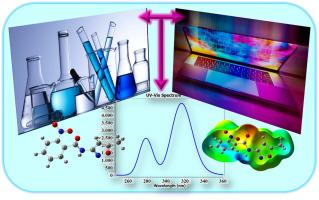Design, synthesis, DNA, and BSA-binding of 5-mercapto-1,3,4-thiadiazol and 5-methylisoxazol derivatives: DFT, Molecular dockings, ADMET, and drug-likeness profiles
IF 4.7
2区 化学
Q2 CHEMISTRY, PHYSICAL
引用次数: 0
Abstract
A new series of 5-mercapto-1,3,4-thiadiazol (SH-2NBA, SH-3NBA, and SH-4NBA), and 5-methylisoxazol (OX-2NBA, OX-3NBA, and OX-4NBA) bearing mercapto or methyl moieties were synthesized by the reaction of 2,3,4-nitrobenzoyl chloride with 5-amino-1,3,4-thiadiazole-2-thiol and 3-amino-5-methylisoxazole in the presence of toluene-TEA. Their structures were characterized with 1H NMR, 13C NMR, UV, and FT-IR. These compounds possess a broad variety of functional activities and have become the subject of considerable growing interest for designing synthesis. The quantum mechanical computations were performed at B3LYP/6–311G** level in both the gas and DMSO simulation environments, for structural and spectroscopic confirmation, then evaluation of the chemical reactivity behavior of the thiadiazol and oxazol isomers. The solubility in octanol and water, ADMET, and drug-likeness properties were elucidated to predict the possible pharmacokinetic profiles, drug-likeness properties, and bioavailability indexes, which would provide a deep insight into early-stage drug-design works. Additionally, BSA binding and DNA binding properties of the molecules were evaluated using spectrophotometric methods. BSA binding properties were analyzed by the Stern-Volmer method, while DNA binding analyses were performed by the Benesi-Hildebrand method. Additionally, the details of both BSA and DNA binding properties were evaluated using molecular docking methods.

5-巯基-1,3,4-噻二唑和5-甲基异恶唑衍生物的设计、合成、DNA和bsa结合:DFT、分子对接、ADMET和药物相似谱
在甲苯- tea的存在下,2,3,4-硝基苯甲酰氯与5-氨基-1,3,4-噻二唑-2-硫醇和3-氨基-5-甲基异恶唑反应合成了一系列含巯基或甲基的5-巯基-1,3,4-噻二唑(SH-2NBA、SH-3NBA和SH-4NBA)和5-甲基异恶唑(OX-2NBA、OX-3NBA和OX-4NBA)。用1H NMR、13C NMR、UV和FT-IR对其结构进行了表征。这些化合物具有广泛的功能活性,已成为设计合成的重要课题。在B3LYP/ 6-311G **水平下,在气体和DMSO模拟环境下进行量子力学计算,进行结构和光谱确认,然后评估噻二唑和恶唑异构体的化学反应性行为。通过分析其在辛醇和水中的溶解度、ADMET和药物相似特性,预测其可能的药代动力学特征、药物相似特性和生物利用度指标,为早期药物设计工作提供深入的见解。此外,用分光光度法评价了分子的BSA结合性能和DNA结合性能。BSA结合特性采用Stern-Volmer法分析,DNA结合特性采用Benesi-Hildebrand法分析。此外,利用分子对接方法评估了BSA和DNA结合特性的细节。
本文章由计算机程序翻译,如有差异,请以英文原文为准。
求助全文
约1分钟内获得全文
求助全文
来源期刊

Journal of Molecular Structure
化学-物理化学
CiteScore
7.10
自引率
15.80%
发文量
2384
审稿时长
45 days
期刊介绍:
The Journal of Molecular Structure is dedicated to the publication of full-length articles and review papers, providing important new structural information on all types of chemical species including:
• Stable and unstable molecules in all types of environments (vapour, molecular beam, liquid, solution, liquid crystal, solid state, matrix-isolated, surface-absorbed etc.)
• Chemical intermediates
• Molecules in excited states
• Biological molecules
• Polymers.
The methods used may include any combination of spectroscopic and non-spectroscopic techniques, for example:
• Infrared spectroscopy (mid, far, near)
• Raman spectroscopy and non-linear Raman methods (CARS, etc.)
• Electronic absorption spectroscopy
• Optical rotatory dispersion and circular dichroism
• Fluorescence and phosphorescence techniques
• Electron spectroscopies (PES, XPS), EXAFS, etc.
• Microwave spectroscopy
• Electron diffraction
• NMR and ESR spectroscopies
• Mössbauer spectroscopy
• X-ray crystallography
• Charge Density Analyses
• Computational Studies (supplementing experimental methods)
We encourage publications combining theoretical and experimental approaches. The structural insights gained by the studies should be correlated with the properties, activity and/ or reactivity of the molecule under investigation and the relevance of this molecule and its implications should be discussed.
 求助内容:
求助内容: 应助结果提醒方式:
应助结果提醒方式:


